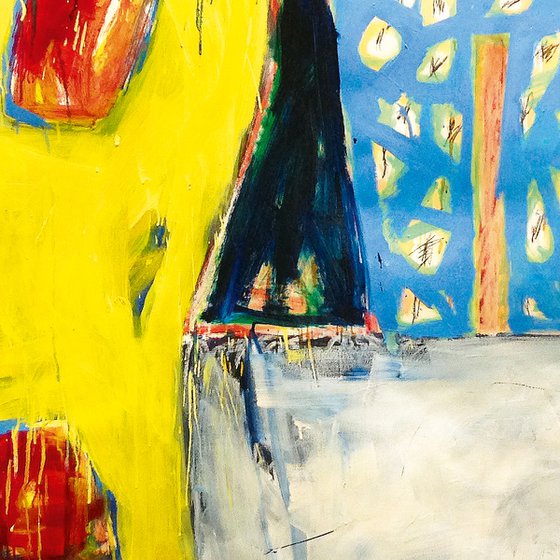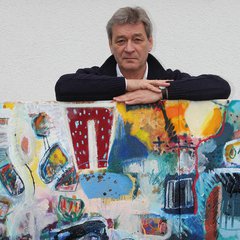- By medium
- By subject
- By budget
- Sales
- Gift cards
- Discover all art
- Artists
- Editors’ picks
- Ideas
Original artwork description:
What's true?
Can a work of art provide an answer to this?
A painting is in itself an illusion, an 'imagination' in the true sense of the word. Unless it only wanted to mean itself, in its color, in its structure and in its materiality. Then it is 'true' in and of itself and evades the function of wanting to express something or of being a vehicle for a specific purpose.
Anyone who is not satisfied with this, but engages in the 'opposite' of the picture, interprets it and appropriates it mentally. He internalizes it and thus makes it his own image. What he sees becomes his 'imagination'.
So does the interpretation by the viewer lead away from the 'truth' of the picture? Or do many perspectives arise from individual perception that claim to be 'true'? And are these different perspectives not exactly a prerequisite for a lively dialogue about the question: “What is true?” This dialogue can lead to a consensus; but it can also be that different perspectives justifiably remain.
Do we not have to mistrust the 'only true' in all its political, social, cultural and religious manifestations? It is part of spiritual honesty to examine other views of what is 'true', to want to understand them - be it in order to agree with them or not to be able to accept them. To represent something as 'true' also requires openness towards what the other person considers 'true'.
We only ever have the result of a process in mind - be it a work of art or a spiritual position. Part of the mystery of the whole truth is the question of the origin and the prerequisites on which this origin is based. Truth has a story. The human being is only able to recognize this as a whole to a limited extent in his limitedness in the 'now'.
But doesn't this openness to the other's claim to truth also have limits? Intolerance, for example, is not tolerable. And where an absolute claim to truth is inhuman and despising of creation, it becomes a betrayal of the truth.
What's true?
Perhaps we need to be able to understand that 'being true' always goes hand in hand with 'not knowing'. The consequence of this is respect for the secret of the other: for the secret of the other person and his view of the 'true'. Also in relation to the mystery, the 'inexpressible' of the picture. "It is the moments of non-understanding that are fundamental for the experience of art." (Adam Szymczyk)
Was ist wahr?
Kann ein Kunstwerk darauf eine Antwort geben?
Ein Gemälde ist an sich Illusion, eine ‚Ein-Bildung‘ im eigentlichen Sinn des Wortes. Es sei denn, es wollte nur sich selbst bedeuten, in seiner Farbe, in seiner Struktur und in seiner Materialität. Dann ist es aus sich selbst heraus ‚wahr‘ und entzieht sich der Funktion, etwas zum Ausdruck bringen zu wollen oder Vehikel für einen bestimmten Zweck zu sein.
Wer sich damit nicht zufrieden gibt, sondern sich auf das ‚Gegenüber‘ des Bildes einlässt, der interpretiert es und eignet es sich gedanklich an. Er verinnerlicht es und macht es so zu seinem eigenen Bild. Was er sieht, wird zu seiner ‚Ein-Bildung‘.
Führt also die Interpretation durch den Betrachter weg von der ‚Wahrheit‘ des Bildes? Oder ergeben sich aus der individuellen Wahrnehmung viele Sichtweisen, die den Anspruch erheben, ‚wahr‘ zu sein? Und sind diese verschiedenen Sichtweisen nicht geradezu Voraussetzung für einen lebendigen Dialog über die Frage: „Was ist wahr?“ Dieser Dialog kann zu einem Konsens führen; es kann aber auch sein, dass unterschiedliche Sichtweisen berechtigt bestehen bleiben.
Müssen wir nicht dem ‚einzig Wahren‘ in allen seinen politischen, gesellschaftlichen, kulturellen und religiösen Ausprägungen misstrauen? Es gehört zur geistigen Redlichkeit, andere Sichtweisen dessen, was ‚wahr‘ ist, zu prüfen, sie verstehen zu wollen – sei es, um ihnen zuzustimmen oder aber sie nicht übernehmen zu können. Selbst etwas als ‚wahr‘ zu vertreten fordert auch die Offenheit gegenüber dem, was der Andere für ‚wahr‘ hält.
Wir haben immer nur das Ergebnis eines Prozesses vor Augen – sei es ein Kunstwerk oder sei es eine geistige Position. Zum Geheimnis der ganzen Wahrheit gehört die Frage nach dem Entstehen und den Voraussetzungen, die diesem Entstehen zugrunde liegen. Wahrheit hat eine Geschichte. Diese als Ganze zu erkennen ist der Mensch in seiner Begrenztheit im ‚Jetzt‘ nur eingeschränkt fähig.
Hat diese Offenheit gegenüber dem Wahrheitsanspruch des Anderen aber nicht auch Grenzen? Intoleranz etwa ist nicht tolerabel. Und wo ein verabsolutierter Anspruch auf Wahrheit menschenverachtend und schöpfungsverachtend ist, wird er zum Verrat an der Wahrheit.
Was ist wahr?
Vielleicht müssen wir zu der Einsicht fähig werden, dass ‚wahr sein‘ immer auch mit ‚nicht wissen‘ einhergeht. Die Konsequenz daraus ist die Achtung gegenüber dem Geheimnis des Anderen: gegenüber dem Geheimnis des anderen Menschen und seiner Sicht des ‚Wahren‘. Auch gegenüber dem Geheimnis, dem ‚Unsagbaren‘ des Bildes. „Es sind die Momente des Nicht-Verstehens, die fundamental sind für die Erfahrung von Kunst.“ (Adam Szymczyk)
Materials used:
mixed Media
Tags:
#original #colorful #abstraction #big #newno title (What's true?) (2017) Mixed-media painting
by Michael Thümmrich
£4,601.58
- Mixed-media painting on Paper
- One of a kind artwork
- Size: 180 x 180 x 5cm (framed)
- Framed and ready to hang
- Signed on the front
- Style: Abstract
- Subject: Abstract and non-figurative
Loading
Original artwork description
What's true?
Can a work of art provide an answer to this?
A painting is in itself an illusion, an 'imagination' in the true sense of the word. Unless it only wanted to mean itself, in its color, in its structure and in its materiality. Then it is 'true' in and of itself and evades the function of wanting to express something or of being a vehicle for a specific purpose.
Anyone who is not satisfied with this, but engages in the 'opposite' of the picture, interprets it and appropriates it mentally. He internalizes it and thus makes it his own image. What he sees becomes his 'imagination'.
So does the interpretation by the viewer lead away from the 'truth' of the picture? Or do many perspectives arise from individual perception that claim to be 'true'? And are these different perspectives not exactly a prerequisite for a lively dialogue about the question: “What is true?” This dialogue can lead to a consensus; but it can also be that different perspectives justifiably remain.
Do we not have to mistrust the 'only true' in all its political, social, cultural and religious manifestations? It is part of spiritual honesty to examine other views of what is 'true', to want to understand them - be it in order to agree with them or not to be able to accept them. To represent something as 'true' also requires openness towards what the other person considers 'true'.
We only ever have the result of a process in mind - be it a work of art or a spiritual position. Part of the mystery of the whole truth is the question of the origin and the prerequisites on which this origin is based. Truth has a story. The human being is only able to recognize this as a whole to a limited extent in his limitedness in the 'now'.
But doesn't this openness to the other's claim to truth also have limits? Intolerance, for example, is not tolerable. And where an absolute claim to truth is inhuman and despising of creation, it becomes a betrayal of the truth.
What's true?
Perhaps we need to be able to understand that 'being true' always goes hand in hand with 'not knowing'. The consequence of this is respect for the secret of the other: for the secret of the other person and his view of the 'true'. Also in relation to the mystery, the 'inexpressible' of the picture. "It is the moments of non-understanding that are fundamental for the experience of art." (Adam Szymczyk)
Was ist wahr?
Kann ein Kunstwerk darauf eine Antwort geben?
Ein Gemälde ist an sich Illusion, eine ‚Ein-Bildung‘ im eigentlichen Sinn des Wortes. Es sei denn, es wollte nur sich selbst bedeuten, in seiner Farbe, in seiner Struktur und in seiner Materialität. Dann ist es aus sich selbst heraus ‚wahr‘ und entzieht sich der Funktion, etwas zum Ausdruck bringen zu wollen oder Vehikel für einen bestimmten Zweck zu sein.
Wer sich damit nicht zufrieden gibt, sondern sich auf das ‚Gegenüber‘ des Bildes einlässt, der interpretiert es und eignet es sich gedanklich an. Er verinnerlicht es und macht es so zu seinem eigenen Bild. Was er sieht, wird zu seiner ‚Ein-Bildung‘.
Führt also die Interpretation durch den Betrachter weg von der ‚Wahrheit‘ des Bildes? Oder ergeben sich aus der individuellen Wahrnehmung viele Sichtweisen, die den Anspruch erheben, ‚wahr‘ zu sein? Und sind diese verschiedenen Sichtweisen nicht geradezu Voraussetzung für einen lebendigen Dialog über die Frage: „Was ist wahr?“ Dieser Dialog kann zu einem Konsens führen; es kann aber auch sein, dass unterschiedliche Sichtweisen berechtigt bestehen bleiben.
Müssen wir nicht dem ‚einzig Wahren‘ in allen seinen politischen, gesellschaftlichen, kulturellen und religiösen Ausprägungen misstrauen? Es gehört zur geistigen Redlichkeit, andere Sichtweisen dessen, was ‚wahr‘ ist, zu prüfen, sie verstehen zu wollen – sei es, um ihnen zuzustimmen oder aber sie nicht übernehmen zu können. Selbst etwas als ‚wahr‘ zu vertreten fordert auch die Offenheit gegenüber dem, was der Andere für ‚wahr‘ hält.
Wir haben immer nur das Ergebnis eines Prozesses vor Augen – sei es ein Kunstwerk oder sei es eine geistige Position. Zum Geheimnis der ganzen Wahrheit gehört die Frage nach dem Entstehen und den Voraussetzungen, die diesem Entstehen zugrunde liegen. Wahrheit hat eine Geschichte. Diese als Ganze zu erkennen ist der Mensch in seiner Begrenztheit im ‚Jetzt‘ nur eingeschränkt fähig.
Hat diese Offenheit gegenüber dem Wahrheitsanspruch des Anderen aber nicht auch Grenzen? Intoleranz etwa ist nicht tolerabel. Und wo ein verabsolutierter Anspruch auf Wahrheit menschenverachtend und schöpfungsverachtend ist, wird er zum Verrat an der Wahrheit.
Was ist wahr?
Vielleicht müssen wir zu der Einsicht fähig werden, dass ‚wahr sein‘ immer auch mit ‚nicht wissen‘ einhergeht. Die Konsequenz daraus ist die Achtung gegenüber dem Geheimnis des Anderen: gegenüber dem Geheimnis des anderen Menschen und seiner Sicht des ‚Wahren‘. Auch gegenüber dem Geheimnis, dem ‚Unsagbaren‘ des Bildes. „Es sind die Momente des Nicht-Verstehens, die fundamental sind für die Erfahrung von Kunst.“ (Adam Szymczyk)
Materials used:
mixed Media
Tags:
#original #colorful #abstraction #big #new14 day money back guaranteeLearn more


